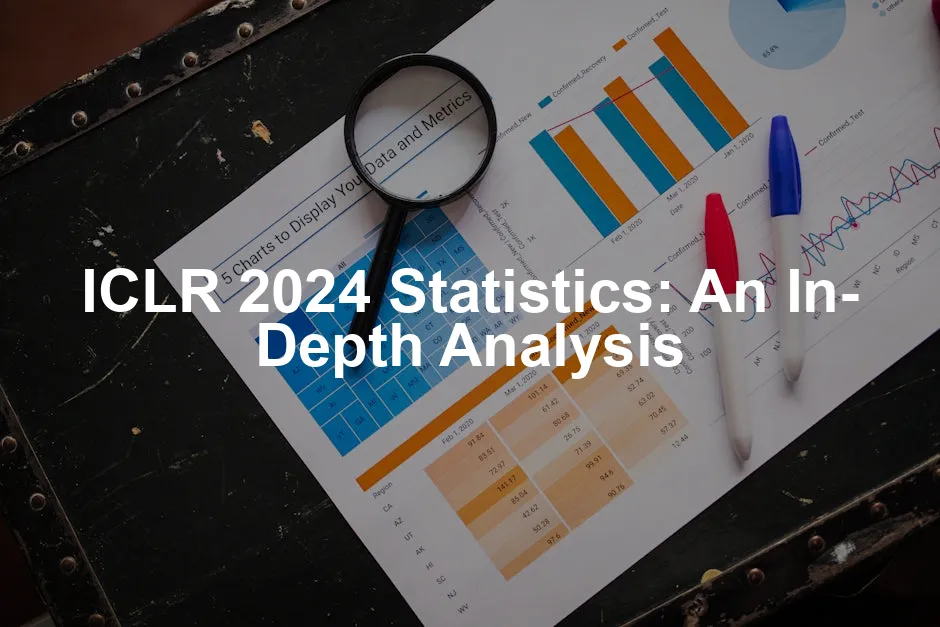Introduction
The International Conference on Learning Representations (ICLR) is a significant event in the realm of artificial intelligence and machine learning. Each year, it gathers researchers, industry experts, and enthusiasts to share groundbreaking ideas and research. ICLR has become a beacon for innovation, showcasing the latest advancements in deep learning and representation learning.
Set to take place from May 7 to May 11, 2024, in the picturesque city of Vienna, Austria, ICLR 2024 promises to be an exciting hub of knowledge and networking. It is here that the brightest minds will gather to discuss the future of AI and machine learning, making it a must-attend event for anyone passionate about the field.
This article aims to provide an in-depth overview of the statistics from ICLR 2024. We will compare these statistics with those from previous years, shedding light on trends in submissions, acceptance rates, and the overall competitiveness of the conference. By analyzing these numbers, we can gain insights into the evolving landscape of AI research and what it means for authors and researchers alike.
If you’re looking to dive deeper into the world of AI and machine learning, consider picking up a copy of Artificial Intelligence: A Guide to Intelligent Systems. This book is perfect for anyone wanting to understand the fundamentals of AI and how to apply them practically. Don’t be left behind in the AI revolution!

ICLR 2024 Overview
Conference Details
ICLR 2024 will be held at the Messe Wien Exhibition and Congress Center in Vienna, Austria. This venue is not just a beautiful setting; it’s equipped to host a variety of events, making it ideal for a conference of this magnitude. Attendees can expect a well-structured agenda filled with keynotes, workshops, and poster sessions that foster collaboration and engagement.
The importance of ICLR in the AI research community cannot be overstated. It has established itself as a premier venue for presenting cutting-edge research. The conference highlights not only theoretical advancements but also practical applications of machine learning across various fields, including computer vision, natural language processing, and robotics.
The structure of the conference will include keynote speeches from leading experts, interactive workshops, and poster sessions, allowing for deeper engagement with the presented material. Keynote speakers will share their insights, providing attendees with the opportunity to learn from the best in the business. Workshops will focus on hands-on learning and collaboration, while poster sessions will allow researchers to present their work in a more informal setting, encouraging discussions and feedback.
As we look forward to ICLR 2024, it’s clear that this conference will serve as a pivotal moment for the AI community. It will not only showcase the latest research but also set the stage for future innovations in the field. With a robust lineup and an enthusiastic audience, ICLR 2024 is poised to be an unforgettable experience for all involved.
For those who want to enhance their understanding of machine learning, I highly recommend Hands-On Machine Learning with Scikit-Learn, Keras, and TensorFlow. This book offers practical insights and projects that will help you understand the concepts effectively. It’s a must-have for aspiring data scientists!

Key Statistics for ICLR 2024
The International Conference on Learning Representations (ICLR) 2024 is shaping up to be a remarkable event in the AI research community. With a staggering total of 7,304 submissions, the competition is fierce! This figure marks a significant increase from previous years, indicating a growing interest in the conference and the field of machine learning.
The acceptance rate for ICLR 2024 stands at 30.94%, with 2,260 papers accepted. What does this mean for authors and researchers? Well, it highlights a crucial aspect: the increasing competitiveness of the conference. As more researchers submit high-quality work, the bar is set higher for acceptance.
For authors, this surge in submissions could mean several things. First, it emphasizes the need for originality and rigor in their work. Simply put, mediocre papers are less likely to be accepted in such a competitive environment. Researchers must ensure their submissions stand out, not only in creativity but also in clarity and contribution to the field.
If you’re looking to sharpen your skills in machine learning, consider reading Python Machine Learning. This book provides a comprehensive guide to implementing machine learning algorithms using Python, helping you to build your skills from the ground up.
Moreover, this statistic suggests that the quality of submissions is likely improving. With a larger pool of applicants, the conference can afford to be selective. Consequently, accepted papers may reflect the cutting-edge of AI research, offering attendees a wealth of knowledge and insight into the latest trends and innovations.
In summary, ICLR 2024’s statistics underscore a vibrant and competitive landscape for AI research. Authors should be prepared to elevate their work to meet the high expectations of both reviewers and attendees. With the stakes higher than ever, it’s an exciting time to be involved in AI research!

The statistics from ICLR 2024, including the iclr 2024 statistics, highlight the growing competitiveness and interest in AI research.
Acceptance Rates by Presentation Type
At ICLR 2024, the distribution of accepted papers by presentation type gives us a fascinating look into the conference’s focus areas. Out of the 2,260 accepted papers, the breakdown is as follows:
- Oral Presentations: 86 papers (3.8% of submissions)
- Spotlight Presentations: 367 papers (16.2% of submissions)
- Poster Presentations: 1,807 papers (80% of submissions)
This distribution reflects a clear emphasis on poster presentations, which dominate the acceptance rates. Why the preference? Well, poster sessions allow for more interactive discussions between authors and attendees. Researchers love the opportunity to showcase their work and engage in dynamic conversations. It’s like an academic speed-dating event, minus the awkward silences.
Oral presentations, while fewer, highlight some of the most groundbreaking work. These slots are reserved for work that truly pushes boundaries. If your paper gets an oral presentation, it’s like winning the lottery—everyone wants to hear your groundbreaking ideas firsthand.
Spotlight presentations are a nice middle ground, providing authors with the chance to present their work in a more focused session, giving them a spotlight moment without the full pressure of an oral presentation.
Overall, the distribution reflects ICLR’s commitment to fostering a vibrant exchange of ideas, with a strong inclination towards formats that encourage interaction and collaboration among attendees. This trend signals where the conference’s priorities lie: engaging dialogue and community-building in the AI research landscape.

Detailed Statistical Analysis
Rating Distribution
Analyzing the ratings for accepted papers at ICLR 2024 provides a revealing glimpse into the review process. The rating statistics for accepted papers are as follows:
- Minimum Rating: 3.60
- Maximum Rating: 9.00
- Average Rating: 6.44
- Standard Deviation: 0.70
The spread of ratings suggests that while there are some standout papers, the majority of accepted work is solidly above average. A minimum rating of 3.60 indicates that even the least favorably reviewed papers still demonstrate a level of quality. It’s like being the kid in class who didn’t study but still managed to pass with a C—better than a fail but not exactly valedictorian material.
Visualizations, such as box plots and histograms, can effectively illustrate this distribution. They reveal nuances in how reviewers score submissions. For instance, a box plot can show the median, quartiles, and potential outliers. This graphical representation helps us see not just the average but also the variance—essential in understanding the review dynamics.
So, what influences these ratings? Several factors come into play. Reviewer biases can shape scores, especially if a paper aligns with a particularly hot topic or a favored methodology. Trends in research topics also matter. If a paper hits upon a trending theme—think large language models or generative networks—it might receive a more favorable score simply because it’s what everyone is buzzing about. This isn’t to say that quality is secondary; rather, the zeitgeist often influences how groundbreaking is perceived.
If you’re curious about deep learning’s impact, check out Deep Learning by Ian Goodfellow. This book dives into the intricacies of neural networks and how they are reshaping our understanding of data. It’s a must-read for anyone serious about diving into AI!

Withdrawals and Desk Rejections
The rates of withdrawals and desk rejections at ICLR 2024 provide insight into the submission landscape compared to previous years. For 2024, there were 86 withdrawals and 3,449 desk rejections.
When we compare these numbers to past ICLR statistics, we see a slight increase in the desk rejection rate. This suggests a tightening of the review process. Authors are likely facing stricter scrutiny, which could be a result of the increasing number of submissions. A more competitive field means reviewers have to be more discerning.
What does this mean for authors? Well, it’s a double-edged sword. On one hand, it reflects a rigorous process that upholds the quality of the conference. On the other, it may discourage some authors from submitting their work. The implications are significant: researchers must ensure their papers are not only well-written but also contribute meaningfully to the conversation.
Ultimately, these statistics reflect the evolving landscape of ICLR. Authors must navigate heightened expectations while striving to produce innovative, high-quality research. The pressure is on, but it’s also an opportunity for growth and collaboration in the vibrant AI community.

Insights from Major Contributors
ICLR 2024 attracts top-tier contributors from around the globe. Institutions like Stanford, MIT, and Google Research stand out with multiple accepted papers. These powerhouses are not just participants; they set the tone for the conference with their innovative research.
Research groups have also made significant impacts. For instance, Sony AI showcased groundbreaking work in generative models. Their papers focused on enhancing the robustness of AI systems. Notably, they presented findings on federated learning, highlighting their commitment to ethical AI practices.
If you want to explore the fascinating world of machine learning, grab a copy of The Elements of Statistical Learning. This book provides a deep dive into statistical modeling and machine learning, making it a valuable resource for researchers and practitioners alike.
The types of research that garnered the most attention at ICLR 2024 included large language models and diffusion models. These areas showcased a surge of interest, as authors explored their applications in diverse fields. Papers on generative AI methods, particularly in text-to-image synthesis, consistently captured the spotlight.
Moreover, reinforcement learning and its applications in real-world scenarios received notable attention. Researchers presented strategies to improve model efficiency while maintaining high performance. This trend reflects a broader shift towards practical applications of AI, aiming to solve real-world problems.
Overall, ICLR 2024 highlighted the best and brightest minds in AI. The diversity of research topics and the influence of major contributors set the stage for future advancements in the field.

Significance of the Findings
The statistics from ICLR 2024 reveal insights that extend beyond numbers. With 7,304 submissions and a 30.94% acceptance rate, the conference marks a turning point for AI research. This growth signals increased interest and competitiveness, reshaping how researchers approach their work.
Understanding trends in submissions is vital for prospective authors. The rise in submissions indicates a need for originality and clarity. Authors must ensure their papers stand out. As the quality of accepted papers escalates, so do the expectations. This evolution demands that researchers innovate continuously, pushing the boundaries of their fields.
If you’re keen on improving your research skills, don’t miss out on Machine Learning Yearning by Andrew Ng. This guide will help you structure your machine learning projects and set you on the right path to success!
Acceptance rates provide a roadmap for navigating future submissions. For instance, analyzing which topics gained traction can guide researchers in selecting areas of focus. Historically, papers on large language models and generative techniques have dominated. Future authors should consider aligning their work with these trends.
Moreover, the conference’s emphasis on interactive formats, such as poster sessions, encourages collaboration. This environment fosters discussions that can lead to new ideas and partnerships. Researchers should capitalize on these opportunities, networking and engaging with peers to enhance their work.
In summary, the findings from ICLR 2024 illuminate the path forward for AI research. By understanding submission trends and the competitive landscape, researchers can better prepare for future submissions. The evolving metrics not only reflect the current state of AI but also serve as a guide for aspiring contributors to the field.

Conclusion
In this comprehensive overview of ICLR 2024 statistics, we’ve explored several key points that underline the significance of this event in the AI and machine learning landscape. With a staggering 7,304 submissions and an acceptance rate of 30.94%, ICLR 2024 showcases a vibrant and competitive environment. The increase in submissions compared to previous years illustrates a growing interest in the conference, highlighting the importance of originality and rigor in research.
The distribution of accepted papers, especially the predominance of poster presentations, reveals the conference’s commitment to fostering interactive discussions. This format allows authors to engage directly with attendees, creating a lively atmosphere for knowledge sharing. The emphasis on collaboration and dialogue is vital for the advancement of AI research.
ICLR has consistently played a crucial role in pushing the boundaries of AI and machine learning. It serves as a platform for researchers to present groundbreaking work, paving the way for future innovations. As the conference evolves, it reflects the trends and challenges faced by the AI community. Keeping an eye on emerging topics and areas of interest will be essential for researchers looking to contribute to this dynamic field.
Looking ahead, it’s clear that ICLR will continue to be a cornerstone of AI research. The high caliber of accepted papers signals a bright future for the conference. Researchers and practitioners alike should stay tuned for upcoming events, as they represent not just opportunities for networking, but also a chance to witness the evolution of AI research in real-time. The landscape is changing rapidly, and ICLR remains at the forefront of these advancements.

FAQs
What is ICLR?
The International Conference on Learning Representations (ICLR) is a premier event dedicated to the advancement of representation learning. It brings together researchers, industry experts, and enthusiasts to discuss the latest trends and breakthroughs in AI and machine learning. The conference focuses on various aspects of deep learning, including theoretical advancements and practical applications across fields like computer vision and natural language processing.
How can I submit a paper to ICLR?
Submitting a paper to ICLR involves a structured process. Authors must create an account on the OpenReview platform, where they can upload their submissions. Key deadlines include initial submission dates, rebuttal periods, and final decisions. It’s essential for authors to follow the guidelines outlined on the ICLR website to ensure their papers are eligible for consideration.
What are the benefits of attending ICLR?
Attending ICLR offers numerous benefits. Participants gain exposure to cutting-edge research and innovative ideas in AI. The conference fosters networking opportunities, allowing attendees to connect with leading researchers and industry professionals. Additionally, ICLR provides a platform for collaboration, enabling researchers to discuss potential partnerships and projects.
How do the acceptance rates affect authors?
Acceptance rates play a significant role in shaping authors’ expectations. A lower acceptance rate often indicates increased competition, prompting authors to elevate the quality and originality of their submissions. Understanding past acceptance trends can help authors strategize their research focus and improve their chances of acceptance in future conferences.
What are the trending research topics in ICLR 2024?
At ICLR 2024, several research areas gained significant traction. Topics such as large language models, diffusion models, and federated learning highlighted the conference’s focus on practical applications of AI. Understanding these trends can guide researchers in aligning their work with current interests in the AI community.
What resources are available for ICLR attendees?
ICLR attendees have access to a variety of resources, including workshops, tutorials, and networking events. Workshops provide hands-on learning experiences, while tutorials offer in-depth knowledge on specific topics. Networking events facilitate connections among researchers, fostering collaboration and idea exchange. These resources enhance the overall conference experience, making it a valuable event for all participants.
Please let us know what you think about our content by leaving a comment down below!
Thank you for reading till here 🙂
All images from Pexels




